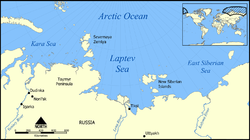Laptev sea
| Laptev Sea | |
|---|---|
 |
|
| Coordinates | 76°16′7″N 125°38′23″E / 76.26861°N 125.63972°ECoordinates: 76°16′7″N 125°38′23″E / 76.26861°N 125.63972°E |
| Type | Sea |
| Basin countries | Russia |
| Surface area | 700,000 km2 (270,000 sq mi) |
| Average depth | 578 m (1,896 ft) |
| Max. depth | 3,385 m (11,106 ft) |
| Water volume | 403,000 km3 (3.27×1011 acre·ft) |
| References | |
The Laptev Sea (Russian: мо́ре Ла́птевых, more Laptevykh) is a marginal sea of the Arctic Ocean. It is located between the northern coast of Siberia, the Taimyr Peninsula, Severnaya Zemlya and the New Siberian Islands. Its northern boundary passes from the Arctic Cape to a point with co-ordinates of 79°N and 139°E, and ends at the Anisiy Cape. The Kara Sea lies to the west, the East Siberian Sea to the east.
The sea is named after the Russian explorers Dmitry Laptev and Khariton Laptev; formerly, it had been known under various names, the last being Nordenskiöld Sea (Russian: мо́ре Норденшёльда), after explorer Adolf Erik Nordenskiöld. The sea has a severe climate with temperatures below 0 °C (32 °F) over more than 9 months per year, low water salinity, scarcity of flora, fauna and human population, and low depths (mostly less than 50 meters). It is frozen most of the time, though generally clear in August and September.
The sea shores were inhabited for thousands of years by indigenous tribes of Yukaghirs and then Evens and Evenks, which were engaged in fishing, hunting and reindeer husbandry. They were then settled by Yakuts and later by Russians. Russian explorations of the area started in the 17th century. They came from the south via several large rivers which empty into the sea, such as the prominent Lena River, the Khatanga, the Anabar, the Olenyok, the Omoloy and the Yana. The sea contains several dozen islands, many of which contain well-preserved mammoth remains.
...
Wikipedia
